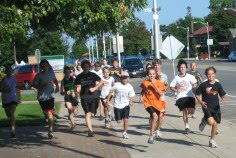Peace in an Interconnected World
Monday, September 14, 2009

The following was first posted at Ashoka.org in answer to the question: What does peace building look like in an interconnected world?
As a very active four-year member of the Delta County Coalition Against Homelessness and a former workforce development professional, I observe many agencies doing wonderful, well-intentioned work - yet still largely in isolation of one-another. This isolation leads to unneccessary duplication of effort and greatly limits effectiveness and innovation.
Systems theory, along with embracing the principles of the learning organization are essential to fundamental change in our present economic and environmental circumstances. For example, what sense does it make for social service agencies to demand of their clients that they attain financial self-sufficiency when the agencies themselves are operating with almost complete dependency under the trickling faucet of government funding and relentless annual giving campaigns? I have met many social service clients in our community who are every bit as qualified or capable of performing the same duties as the agency staff person who is reviewing and approving their benefits request. What has happened to the real "social work", real compassion, real caring or real involvement? Looking down upon the system as it now operates, as an eagle would view a rats maze from the sky, reveals huge flaws and dangerous extremes that have resulted from our excessive worship of market efficiencies at the expense of community.
What if non-profits and NGOs took on more and more of the role of system change - such as the relocalization of our economies? It is still cost-prohibitive for private enterprise to raise organic produce in Upper Midwest climates. Will Allen of Growing Power is moving toward economic viability in this area but is not there yet. What if instead more local agriculture was initiated by organizations like The Salvation Army - or area churches and schools? Through possible foundation grants, couldn't a local agricultural system be launched, developed and used as a teaching model or learning cooperative for local entrepreneurs? Couldn't the same local agricultural system not only supply our soup kitchens and school cafeterias? How about providing part-time employment that puts better food in the cupboards of social service clients and extra cash in their pockets through sales to farmer's markets or cooperative distribution networks?
Same goes for energy efficient housing. Since the ROI of building with energy efficient systems and products is still too far out on the horizon for the comfort of most private investors, especially in cold-climates, why can't we introduce these technologies through emergency shelter and transitional housing?
The main reason that these ideas are not already in widespread application is because everyone, including non-profits are so deeply entrenched in the system as it has evolved over the past two hundred years or more. Try doing anything innovative and "twenty-first century" through a traditional non-profit in your community. What you find are large boards of directors or deeply vertical administrative heirarchies that have long since fallen into the habit of micro-management. In the age where Twitter and SMS can facilitate a global movement in hours, far too many non-profit, social and civic organizations meet once per month at best and require even some of the most mundane decisions to be approved by a board. Few boards know how to maintain their proper function as setters and keepers of the vision. What you also find in trying to be innovative with social change are state and federal government distribution channels so full of entrenched special interests that innovators and change agents are even excluded by the language of a government request for proposal.
Lean non-profits that have taken a systems and learning organization approach from the very beginning of their inception and incorporation have the potential to be the true tipping point that puts our planet back on track toward peace and interconnectedness. Ignoring the systems approach can only lead to inevitable failure. Peace does not happen in a world where we hide within the walls of our McMansions - never getting to know our neighbors.









0 comments:
Post a Comment